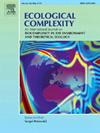Tri-trophic networks of oak gall-inducing-insects and their parasitoids in Mexican avocado agrosystems: Forest coverage and local climatic variables importance
IF 3.1
3区 环境科学与生态学
Q2 ECOLOGY
引用次数: 0
Abstract
Despite trees of temperate forest ecosystems (TFEs) maintain a great diversity of biotic interactions, they are threatened by changes in land use. In Mexico, the main threat to TFEs is the conversion to avocado orchards, generating forest fragmentation affecting trophic networks, like gall-inducing insects (GII) and their parasitoids. We determined the changes in structure and diversity of trophic assemblages of GII and their parasitoids associated in Quercus castanea, Q. obtusata and Q. magnolifolia, as well as the plant vigor roll on GII diversity in sites with different percentages of forest and avocado orchards in Mexico. Per study site, we selected 20 trees with gall presence for each oak species. Also, we assessed climatic variables effects on plant vigor and GII diversity. We found that plant vigor traits and GII diversity for all oak species increases as avocado orchard does. Contrary, a decrease of parasitoid diversity was detected for areas with greater avocado orchard cover. GII diversity had a positive relationship with temperature, but negatively with precipitation in all study sites. Tri-trophic networks differed among sites, having lower connectance and greater modularity in sites with higher avocado orchard cover, while in sites with higher forest cover was the most connected and diverse. Our results suggest that TFEs conversion to avocado orchards increases plant vigor and GII diversity, but decreases parasitoid diversity and modifications in trophic networks. Therefore, we highlight the need to conserve and manage forest remnants in the avocado belt because they preserve and maintain a great diversity of biotic interactions.

墨西哥牛油果农业系统中诱发橡树瘿虫及其拟寄生虫的三营养网络:森林覆盖率和当地气候变量的重要性
尽管温带森林生态系统(tfe)的树木保持了生物相互作用的多样性,但它们受到土地利用变化的威胁。在墨西哥,对tfs的主要威胁是向牛油果果园的转变,造成森林破碎化,影响营养网络,如诱导瘿虫(GII)及其拟寄生虫。研究了墨西哥不同森林和牛油果占比的甘露栎(Quercus castanea)、黑栎(Q. obtusata)和厚朴栎(Q. magnolifolia) GII及其相关寄生蜂营养组合的结构和多样性变化,以及植物活力对GII多样性的影响。在每个研究地点,我们为每种橡树选择了20棵有瘿的树。此外,我们还评估了气候变量对植物活力和GII多样性的影响。结果表明,随着牛油果果园的扩大,所有栎种的植物活力性状和GII多样性均有所增加。相反,在牛油果覆盖面积较大的地区,寄生蜂的多样性有所减少。GII多样性与气温呈正相关,与降水量呈负相关。三营养网络在不同的站点之间存在差异,在牛油果覆被高的站点具有较低的连通性和较大的模块化,而在森林覆被高的站点具有最强的连通性和多样性。研究结果表明,tfe对牛油果果园的转化增加了植物活力和GII多样性,但减少了寄生蜂多样性和营养网络的改变。因此,我们强调需要保护和管理鳄梨带的森林遗迹,因为它们保存和维持了生物相互作用的多样性。
本文章由计算机程序翻译,如有差异,请以英文原文为准。
求助全文
约1分钟内获得全文
求助全文
来源期刊

Ecological Complexity
环境科学-生态学
CiteScore
7.10
自引率
0.00%
发文量
24
审稿时长
3 months
期刊介绍:
Ecological Complexity is an international journal devoted to the publication of high quality, peer-reviewed articles on all aspects of biocomplexity in the environment, theoretical ecology, and special issues on topics of current interest. The scope of the journal is wide and interdisciplinary with an integrated and quantitative approach. The journal particularly encourages submission of papers that integrate natural and social processes at appropriately broad spatio-temporal scales.
Ecological Complexity will publish research into the following areas:
• All aspects of biocomplexity in the environment and theoretical ecology
• Ecosystems and biospheres as complex adaptive systems
• Self-organization of spatially extended ecosystems
• Emergent properties and structures of complex ecosystems
• Ecological pattern formation in space and time
• The role of biophysical constraints and evolutionary attractors on species assemblages
• Ecological scaling (scale invariance, scale covariance and across scale dynamics), allometry, and hierarchy theory
• Ecological topology and networks
• Studies towards an ecology of complex systems
• Complex systems approaches for the study of dynamic human-environment interactions
• Using knowledge of nonlinear phenomena to better guide policy development for adaptation strategies and mitigation to environmental change
• New tools and methods for studying ecological complexity
 求助内容:
求助内容: 应助结果提醒方式:
应助结果提醒方式:


